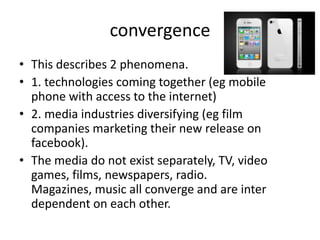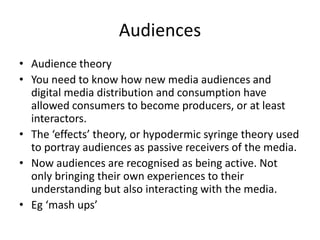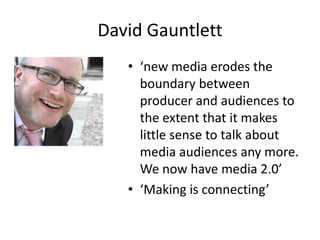Institutions and audiences
- 1. Institutions and Audiences Section B exam
- 2. Institution • Refers to the companies & organisations that provide media content. • For profit, public service or other motives (artistic). • Media is a business.
- 3. • You need to have a brief awareness of the development of the British film industry. The time line is sufficient for this. • We are more concerned with how films are currently produced and distributed in the UK. • You need to consider the ownership, convergence, technologies and globalisation.
- 4. Institutions and audiences Ownership. • The media is a business • The relationship between providers and public is one of power, and not from the top down. • You need to know who owns what, what else they own and how it affects their output. • Who works in the media industry? It is far more diverse than it used to be and far less well paid (only 46% earn over £30,000). It is still not representative of the population in general though and its unlikely that the entire cross section of our society will be equally represented by the media we are provided with.
- 5. convergence • This describes 2 phenomena. • 1. technologies coming together (eg mobile phone with access to the internet) • 2. media industries diversifying (eg film companies marketing their new release on facebook). • The media do not exist separately, TV, video games, films, newspapers, radio. Magazines, music all converge and are inter dependent on each other.
- 6. Audiences • Audience theory • You need to know how new media audiences and digital media distribution and consumption have allowed consumers to become producers, or at least interactors. • The ‘effects’ theory, or hypodermic syringe theory used to portray audiences as passive receivers of the media. • Now audiences are recognised as being active. Not only bringing their own experiences to their understanding but also interacting with the media. • Eg ‘mash ups’
- 7. • One refers to audiences as ‘engaging’ with media, rather than just watching or consuming. This is because it implies that the audience is having a relationship with the text. • Bringing their own cultural identity to the form and/or directly interacting with it.
- 8. • In recent years audiences have ‘fragmented’, instead of broadcasting (a few tv channels which everyone watches) we have narrowcasting to niche audiences. • However!!! Csigo (2007), suggests that convergence has led to audiences ‘falling together’ through multi platform media.
- 9. 360-degree branding • Films promotion seeks to surround us with their brand, multi platform, converged media forms. • Your case studies should show this. • They want to ‘trigger engagement’ (Csigo), in audiences. • You watch a film for half price from your orange phone contract, then join in the trending. #convergence.
- 10. A new ecosystem (Naughton) • It’s a shift from push media to pull media • Push –producers push media at us which we duly (dully) consume. • Pull- we decide what we want and how we want to engage with it (on demand).
- 11. David Gauntlett • ‘new media erodes the boundary between producer and audiences to the extent that it makes little sense to talk about media audiences any more. We now have media 2.0’ • ‘Making is connecting’
- 12. • In 2008 Gauntlett proposed 'the Make and Connect Agenda', an attempt to rethink audience studies in the context of media users as producers as well as consumers of media material. • This argues that there is a shift from a • that harnessing creativity in both Web 2.0 and in other everyday creative activities will play a role in tackling environmental problems.













